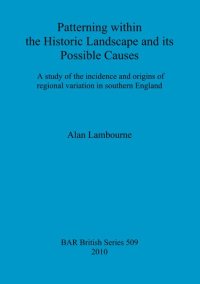
Ebook: Patterning within the Historic Landscape and its Possible Causes: A study of the incidence and origins of regional variation in southern England
Author: Alan Lambourne
- Series: BAR British Archaeological Reports British Series 509
- Year: 2010
- Publisher: BAR Publishing
- Language: English
- pdf
This work takes a fresh look at the phenomenon of 'regional variation' and at the ways in which it has been depicted and characterised. It looks in particular detail at the exercise undertaken by Roberts and Wrathmell to map regional variation and at the Central Province that has been widely adopted as one of the main outcomes of their work. It then analyses the many and varied factors, both environmental and cultural, that have been held to contribute to regional variation, and then applies this theoretical analysis to a study area in southern England. The English landscape is extremely varied, due to geology, topography and climate, but also to the activities of human communities over several millennia. Scholars have long recognised patterns within this variation, such as the upland and lowland zones and the contrasting patterns of human settlement. The purpose of this research is to investigate the incidence of this patterning and then to suggest possible reasons for it. The study starts with a general introduction, in which some themes are identified and a number of conventions established. Regional variation is then discussed in theoretical terms, and the familiar geographical and cultural subdivisions of the historic landscape reviewed at the national level, leading to the identification of a distinct swathe of countryside which is called the 'Central Zone' for the purposes of this work. The various possible causal factors are addressed in the context of a carefully chosen study area, and a number of conclusions are put forward. The existence of a Central Zone is supported, although no definitive delineation is suggested, and its orientation is shown to vary, depending on the period and criteria in question. Conventional explanations for regional variation are examined, and the conventional opposition between environmental and cultural factors is found wanting. Instead a new dynamic is suggested, in which these broad groups of factors are seen to be operating together to create circumstances to which local communities respond by making calculations as to the best strategies to adopt, given their knowledge, resources and traditions. Their decisions determine the detailed development of the landscape, but these are circumscribed in turn by the predisposition of the community itself and of the landscape around it.